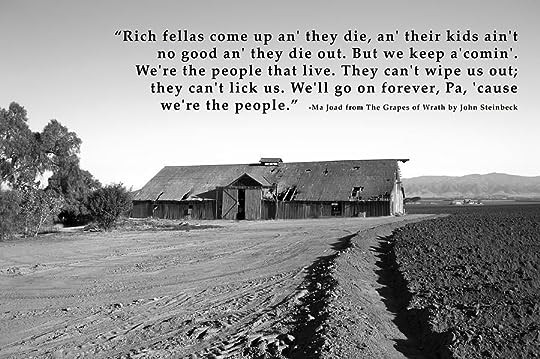“The Grapes of Wrath” is not just a novel; it’s an experience that burrows deep into your soul. If you are considering whether to delve into its pages, let this be your encouragement: Read “The Grapes of Wrath.”
Unlike typical novels that gently guide you into their worlds, “The Grapes of Wrath,” as The Guardian aptly put it, is a story that “stains your teeth with blood.” It’s a stark and poignant tale of the Okies, migrants from Oklahoma, who journeyed towards the promised land of California only to face unimaginable hardships. The Joad family, among thousands of others, were driven from their land and embarked on a westward migration in a dilapidated vehicle. Their pursuit of a better life tragically culminates in despair and destitution, a fate shared by countless fellow migrants.
Misery Upon Misery: Historical Context
The narrative of “The Grapes of Wrath” is deeply rooted in two significant historical events:
1. The Great Depression
The Wall Street Crash of 1929 triggered the Great Depression, plunging America into a severe economic downturn. Banks, desperate to recoup their losses, resorted to land consolidation and mechanized farming using tractors, which proved more economically viable. Consequently, small farmers who had mortgaged their lands and were unable to repay their debts were evicted by the banks. This mass displacement fueled a massive migration from the East to the West Coast, seeking any semblance of opportunity.
2. The Dust Bowl
Beginning in the early 1930s, the Southern Plains of the United States were ravaged by catastrophic dust storms and prolonged drought. This environmental disaster, known as the Dust Bowl, resulted in widespread crop failure, livestock deaths, and human suffering. These devastating conditions amplified the already crippling effects of the Great Depression, forcing farming families to abandon their homes and land in a desperate search for survival and better prospects.
A Controversial Masterpiece?
“The Grapes of Wrath” is arguably one of the most debated and critically analyzed novels of the 20th century. Such impactful works often ignite literary battles, spawning books both in defense and condemnation. This was precisely the fate of Steinbeck’s novel. People in California and Oklahoma voiced strong objections to their portrayal in the book, accusing Steinbeck of spreading falsehoods. Capitalists and politicians readily dismissed the story as communist propaganda, while conservatives took offense at its unconventional interpretations of Christianity and frank language.
However, the true test of a book’s merit lies in the passage of time. As the immediate controversies surrounding the Great Depression receded into history, readers began to approach “The Grapes of Wrath” with a more objective perspective. Confronted with the undeniable realities depicted in the novel, a wider audience came to acknowledge and embrace its powerful narrative.
Whole and Parts: Narrative Structure
The novel employs a distinctive chapter structure. Interspersed between chapters focusing on the Joad family’s journey are broader, more thematic chapters that paint a larger picture of the migrant experience and the social and economic forces at play. While the Joads are absent in these intercalary chapters, the issues and hardships depicted in them are precisely what the Joad family and other migrants ultimately confront.
Without these broader chapters, grasping the full scope of suffering would be challenging. Conversely, focusing solely on the Joads’ plight might obscure the fact that their family represents just a fraction of the hundreds of thousands who endured similar tribulations. This structure effectively balances the personal and the societal, the individual and the collective.
From “Me” to “We”: A Shift in Perspective
A central philosophical theme in “The Grapes of Wrath,” influenced by Steinbeck’s understanding of Marxist ideas, is the power of collective action versus individual vulnerability. Most of the main characters undergo significant personal growth along this trajectory. Tom Joad, the protagonist, starts as a self-centered individual prone to anger. Ma Joad, the family matriarch, initially prioritizes only her immediate family’s well-being. However, through their shared experiences of hardship and loss, both Tom and Ma gradually expand their sense of responsibility beyond their family, striving to assist fellow migrants in any way possible. Ma, despite her family’s own meager food supplies, shares with starving children. Tom, in the climactic moments of the book, makes the momentous decision to join the collective struggle for justice.
However, the most profound transformation from individualism to selflessness is embodied by Rose of Sharon, Tom’s pregnant sister. She begins the journey with her young husband, filled with romantic dreams for the future. But the harsh realities of migrant life progressively shatter her illusions, stripping away her hopes day by day. Ultimately, in the novel’s closing pages, Rose of Sharon becomes the ultimate embodiment of Steinbeck’s philosophy, performing an act of profound empathy and self-sacrifice.
“Women Change Quicker Than Little Geese”: The Strength of Ma Joad
This line, uttered by Ma Joad in response to her husband’s astonishment at her resilience, encapsulates the pivotal role of women in the novel and Ma Joad’s compelling character arc. Set in the patriarchal society of early 20th-century America, the story initially portrays men as the primary decision-makers, with women often excluded from important discussions about the journey ahead.
Yet, as conditions deteriorate and the family faces relentless adversity, Ma Joad emerges as the family’s anchor and guiding force. She gradually assumes control, making crucial decisions to ensure the family’s survival and cohesion. Driven by the singular goal of keeping her family alive and together, Ma Joad rises to the immense challenges, demonstrating remarkable strength and unwavering resolve throughout their arduous journey.
Familiar Pain: Steinbeck’s Connection
John Steinbeck himself was born in Salinas, California, and worked on farms, providing him with firsthand experience of the agricultural landscape and the lives of farmworkers. Before writing “The Grapes of Wrath,” he reported on the dire conditions in migrant camps for newspapers, immersing himself in their world, visiting them frequently, and even traveling alongside migrants. This deep engagement served as crucial preparation for writing the novel. As Steinbeck stated, a writer can only truly write well about what they admire, and for him, nothing was more admirable than the courage and resilience of impoverished people.
English with Translation? What About Audiobook?
It is highly recommended to read “The Grapes of Wrath” in English if possible. Steinbeck’s distinctive dialogue writing is integral to the novel’s impact. He meticulously captures the dialects and unique speech patterns of people from different American states during that era. To enhance the reading experience, consider listening to the audiobook while reading the text. This approach offers several benefits. Firstly, it improves focus and reading speed. Secondly, the narrator’s performance, particularly skilled narrators, makes understanding the various dialects significantly easier and more immersive.
And finally, this quote encapsulates the essence of the book for me:
 The Grapes of Wrath Book Cover
The Grapes of Wrath Book Cover
Here are three excellent articles for further reading:

